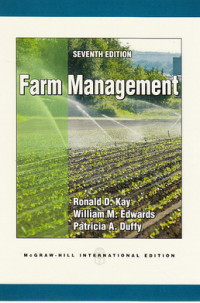Text
Farm management
Farms and ranches, like other small busi¬nesses, require sound management to survive and prosper. The continual development of new agricultural technologies means that farm and ranch managers must stay informed of the lat¬est advances and decide whether to adopt them. Adopting a risky, unproven technology that fails to meet expectations can cause financial diffi¬culties or even termination of the farm business. On the other hand, failing to adopt profitable new technologies will put the farm business at a competitive disadvantage that could also prove disastrous in the long run. In addition, changing public policies regarding environmental protec¬tion, taxes, and price supports can make certain alternatives and strategies more or less profit¬able than they have been in the past. Finally, changes in consumer tastes, the demographic makeup of our population, and world agricul¬tural trade policies affect the demand for agri¬cultural products.
The continual need for farm and ranch man¬agers to keep current and update their skills motivated us to write this seventh edition.
This book is divided into six parts. Part I begins with the chapter "Farm Management in the Twenty-First Century." It describes some of the technological and economic forces driving the changes we see in agriculture. By reading this chapter students will find an incentive to study farm management and an appreciation for the management skills modern farm managers must have or acquire. Part I concludes with an explanation of the concept of management and the decision-making process, with an increased emphasis on the importance of strategic planning and decision making.
Part II presents the basic tools needed to measure management performance, financial progress, and the financial condition of the farm business. It discusses how to collect and orga¬nize accounting data and how to construct and analyze farm financial statements. Data from an example farm is used to demonstrate the analy¬sis process in the chapter on whole farm busi¬ness analysis.
Part III contains three chapters on basic microeconomic principles. The topics in this part provide the basic tools needed to make good management decisions. Students will learn how and when economic principles can be used in management decision-making, along with the importance of the different types of economic costs. The discussion of economies of size has been revised and expanded.
Practical use of budgeting is emphasized in Part IV. The discussion includes chapters on enterprise, partial, whole farm, and cash flow budgets. The format and use for each type of budget, sources of data to use, and break-even analysis techniques are discussed in detail.
Topics necessary to further refine a man¬ager's decision-making skills are included in Part V. Farm business organization, risk con¬trol, income tax management, investment analy¬sis, and enterprise analysis are discussed.
Ketersediaan
Informasi Detail
- Judul Seri
-
-
- No. Panggil
-
630.206 Kay f
- Penerbit
- New York : Mc Graw-Hill., 2012
- Deskripsi Fisik
-
xiv, 466 hal. : il. ; 23 cm.
- Bahasa
-
English
- ISBN/ISSN
-
9780071086561
- Klasifikasi
-
630.206
- Tipe Isi
-
-
- Tipe Media
-
-
- Tipe Pembawa
-
-
- Edisi
-
Ed. VII
- Subjek
- Info Detail Spesifik
-
-
- Pernyataan Tanggungjawab
-
-
Versi lain/terkait
Tidak tersedia versi lain
Lampiran Berkas
Komentar
Anda harus masuk sebelum memberikan komentar

 Karya Umum
Karya Umum  Filsafat
Filsafat  Agama
Agama  Ilmu-ilmu Sosial
Ilmu-ilmu Sosial  Bahasa
Bahasa  Ilmu-ilmu Murni
Ilmu-ilmu Murni  Ilmu-ilmu Terapan
Ilmu-ilmu Terapan  Kesenian, Hiburan, dan Olahraga
Kesenian, Hiburan, dan Olahraga  Kesusastraan
Kesusastraan  Geografi dan Sejarah
Geografi dan Sejarah